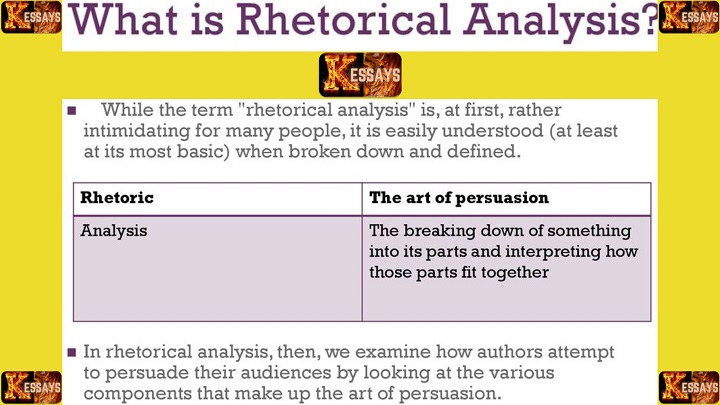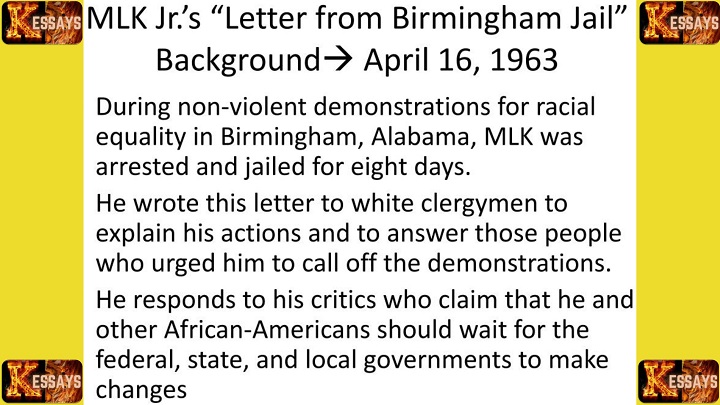Introduction
The "Letter from Birmingham Jail" is a powerful and influential piece of writing by Dr. Martin Luther King Jr., which he penned during his imprisonment in 1963. This letter serves as a response to a public statement by eight white clergymen who criticized King's civil rights activities in Birmingham, Alabama. The letter is not only a defense of King's nonviolent protests but also a call for justice and an end to racial segregation. In this article, we will conduct a critical analysis of the "Letter from Birmingham Jail," examining its rhetorical devices, its impact on the civil rights movement, and its relevance in contemporary society.
I. Rhetorical Devices Employed
Dr. King's "Letter from Birmingham Jail" is renowned for its effective use of rhetorical devices, which contribute to its persuasive power and enduring impact. Throughout the letter, King strategically incorporates various literary techniques to convey his message forcefully. For instance, he employs vivid imagery to describe the unjust treatment of African Americans, appealing to readers' emotions and sense of empathy.
Moreover, his use of repetition, such as the famous phrase "Injustice anywhere is a threat to justice everywhere," reinforces his central argument and underscores the urgency of the civil rights cause. By critically analyzing these rhetorical devices, we gain insight into the letter's rhetorical effectiveness and its ability to galvanize public support.
One of the key rhetorical devices employed by King in the "Letter from Birmingham Jail" is the use of vivid imagery. He skillfully uses descriptive language to paint a picture of the unjust treatment faced by African Americans. For instance, he writes, "when you see the vast majority of your twenty million Negro brothers smothering in an airtight cage of poverty in the midst of an affluent society." This vivid imagery allows readers to visualize the stark contrast between the hardships endured by African Americans and the prosperity enjoyed by others, appealing to their emotions and fostering a sense of empathy.
King's effective use of repetition is a rhetorical device that reinforces his central arguments and enhances their impact. The repetition of key phrases and ideas, such as "Injustice anywhere is a threat to justice everywhere," serves to emphasize the interconnectedness of justice and injustice. This repetition not only strengthens his argument but also leaves a lasting impression on readers, emphasizing the urgency and universal significance of the civil rights cause.
Another rhetorical device employed by King is parallelism, which involves the use of similar grammatical structures to create a sense of balance and rhythm. King's use of parallelism helps to organize his ideas and make them more accessible to the reader. For example, he writes, "In any nonviolent campaign, there are four basic steps: collection of the facts to determine whether injustices exist; negotiation; self-purification; and direct action." This parallel structure enhances the clarity and impact of his message, making it easier for readers to comprehend and remember.

-
Appeals to Ethos, Pathos, and Logos
King strategically employs appeals to ethos, pathos, and logos - the three modes of persuasion - to strengthen his argument. He establishes his credibility (ethos) as a respected leader of the civil rights movement and a reverend, thereby gaining the trust and respect of his audience. Through appeals to emotion (pathos), he evokes empathy and compassion by describing the suffering and injustices faced by African Americans. Additionally, King appeals to reason (logos) by presenting logical arguments supported by evidence and drawing upon historical and philosophical references. This balanced use of ethos, pathos, and logos enhances the persuasiveness of his message.
King incorporates allusions to historical events, religious figures, and philosophical ideas to add depth and resonance to his arguments. For example, he references biblical figures like the Apostle Paul, as well as historical movements such as the Boston Tea Party. These allusions help to establish a shared cultural and historical context with his audience, strengthening his persuasive appeal and highlighting the continuity of the struggle for justice throughout history.
By critically analyzing the
rhetorical devices employed in the "Letter from Birmingham Jail," we gain a deeper understanding of its rhetorical effectiveness. The vivid imagery, repetition, parallelism, appeals to ethos, pathos, and logos, as well as the strategic use of allusions, contribute to the letter's power in conveying its message and mobilizing public support. Dr. King's skillful use of these rhetorical devices is a testament to his ability to engage, persuade, and inspire, leaving a lasting impact on the readers and the civil rights movement as a whole.
II. Impact on the Civil Rights Movement
The "Letter from Birmingham Jail" played a pivotal role in shaping the civil rights movement and advancing the cause of racial equality in the United States. Dr. King's letter resonated with a wide audience and helped mobilize support for the struggle against segregation and discrimination. The letter's publication in various newspapers and its subsequent distribution through other mediums amplified its reach and impact. It became a rallying cry for activists and inspired many to join the fight for justice and equality. By critically analyzing the letter's influence on the civil rights movement, we can appreciate its historical significance and recognize its enduring legacy.
The publication of the "Letter from Birmingham Jail" in various newspapers significantly contributed to its impact. The letter's distribution through widely read publications allowed it to reach a broad audience across the nation. This extensive readership ensured that King's message would be disseminated to individuals from diverse backgrounds, thus fostering awareness and understanding of the civil rights cause.
The letter served as a rallying cry for activists and inspired many to join the fight for justice and equality. King's powerful rhetoric and his call to action resonated deeply with those who were already involved in the civil rights movement and motivated others to become actively engaged. The letter's ability to galvanize support was critical in mobilizing a broader movement that challenged racial segregation and discrimination.
The "Letter from Birmingham Jail" appealed to the moral conscience of its readers. King's eloquent articulation of the injustices faced by African Americans and his impassioned plea for justice and equality touched the hearts and minds of many. By appealing to the moral principles of fairness, compassion, and human rights, the letter compelled individuals to question and confront the deeply ingrained racial prejudices of the time.
The letter emphasized the power and effectiveness of nonviolent resistance as a means of challenging injustice. King eloquently defended the strategic use of nonviolent protests and civil disobedience, emphasizing the moral high ground gained by those who resist peacefully. This approach resonated with a broad audience, including those who may have been skeptical of or opposed to more confrontational tactics. The letter's advocacy for nonviolence helped shape the civil rights movement's philosophy and strategy, emphasizing the importance of peaceful means to achieve lasting change.
The "Letter from Birmingham Jail" continues to be celebrated as a seminal document in the history of the civil rights movement. Its enduring legacy is evident in the recognition and reverence it receives as a powerful articulation of the struggle for racial equality. The letter's influence extends far beyond the time of its writing, inspiring subsequent generations to continue the fight against systemic racism and discrimination.
By critically analyzing the impact of the "Letter from Birmingham Jail" on the civil rights movement, we gain a deeper understanding of its historical significance. The letter's wide audience reach, mobilization of support, moral appeal, advocacy for nonviolent resistance, and enduring legacy all contribute to its profound influence on the advancement of racial equality in the United States. The letter remains an iconic and transformative piece of writing, reminding us of the power of words and the necessity of challenging injustice in pursuit of a more just and equitable society.
III. Relevance in Contemporary Society
Despite the significant progress made since the writing of the "Letter from Birmingham Jail," the persistence of racial inequality and social injustice in contemporary society underscores the ongoing relevance of Dr. Martin Luther King Jr.'s words. By critically analyzing the letter in light of present-day challenges, we can explore its enduring relevance and extract valuable lessons for addressing current societal issues.
Furthermore, the letter's emphasis on the power of nonviolent resistance provides a timeless and compelling framework for peaceful activism and social change. By critically examining the letter's contemporary relevance, we uncover its enduring wisdom and its potential to guide us towards a more just and equitable society.

-
Continuing Struggle for Civil Rights
The persistence of racial inequality and social injustice demonstrates the continued relevance of the "Letter from Birmingham Jail." Dr. King's powerful words serve as a reminder that the fight for civil rights is an ongoing struggle that requires vigilance, activism, and collective action. The letter's exploration of the interconnectedness of justice and injustice compels us to address systemic racism and discrimination in contemporary society.
The "Letter from Birmingham Jail" offers valuable insights for contemporary social justice movements. Its emphasis on nonviolent resistance and the moral imperative to confront injustice provides a compelling framework for peaceful activism. The letter reminds us that meaningful change can be achieved through strategic and disciplined nonviolent protests, as seen in recent movements advocating for racial equality, gender equity, LGBTQ+ rights, and environmental justice.
Dr. King's letter highlights the interconnected nature of social justice struggles. By critically analyzing the letter in a contemporary context, we recognize the importance of intersectionality in addressing multiple forms of oppression and discrimination. King's call for unity and solidarity among different marginalized groups inspires us to work together in dismantling systems of oppression and advocating for equality across various axes of identity.
-
Amplifying Marginalized Voices
The "Letter from Birmingham Jail" underscores the significance of amplifying marginalized voices. In contemporary society, it is crucial to listen to and uplift the voices of those directly impacted by systemic injustice. By critically examining the letter's message, we are reminded of the importance of centering the experiences and perspectives of marginalized communities in our efforts to achieve social justice.
-
The Power of Dialogue and Education
The "Letter from Birmingham Jail" emphasizes the importance of open and honest dialogue, as well as education, in challenging prejudice and promoting understanding. In contemporary society, these principles remain relevant in fostering constructive conversations about race, equality, and justice. The letter encourages us to engage in respectful dialogue and continuous learning to challenge our own biases and promote societal transformation.
By critically analyzing the "Letter from Birmingham Jail" in the context of contemporary challenges, we recognize its continued relevance and its potential to guide us towards a more just and equitable society. Dr. King's words serve as a beacon of hope, reminding us that the struggle for civil rights is an ongoing commitment that requires collective action, nonviolent resistance, and the amplification of marginalized voices. By heeding the lessons of the letter and applying its principles to contemporary issues, we can contribute to the ongoing fight for justice, equality, and human rights in our society.

IV. Critical Analysis of Rhetorical Devices Employed in the "Letter from Birmingham Jail"
Dr. Martin Luther King Jr.'s "Letter from Birmingham Jail" is a masterclass in the effective use of rhetorical devices, which significantly contribute to its persuasive power and enduring impact. Throughout the letter, King strategically incorporates various literary techniques to convey his message forcefully and engage his audience. By critically analyzing these rhetorical devices, we can gain insight into the letter's rhetorical effectiveness and its ability to galvanize public support.
One of the key rhetorical devices employed by King in the "Letter from Birmingham Jail" is the use of vivid imagery. He vividly describes the unjust treatment of African Americans, providing readers with powerful mental images that evoke a strong emotional response.
For example, he writes, "When you suddenly find your tongue twisted and your speech stammering as you seek to explain to your six-year-old daughter why she can't go to the public amusement park that has just been advertised on television, and see tears welling up in her eyes when she is told that Funtown is closed to colored children." This use of imagery enables readers to empathize with the experiences of African Americans and understand the urgency of the civil rights cause.
King employs repetition as a rhetorical device to reinforce his central argument and create a rhythmic and memorable effect. The phrase "Injustice anywhere is a threat to justice everywhere" is a prime example. By repeating this powerful statement throughout the letter, King emphasizes the interconnectedness of justice and injustice, making it clear that the struggle for civil rights is not limited to a specific location but has far-reaching implications for society as a whole. This repetition also serves to drive home the urgency of addressing injustice promptly and decisively.
Another rhetorical device employed by King is parallelism. He skillfully structures his sentences and paragraphs using parallel grammatical constructions, which enhance the clarity and impact of his message. For instance, he writes, "We know through painful experience that freedom is never voluntarily given by the oppressor; it must be demanded by the oppressed." This parallel structure creates a sense of balance and symmetry, making his arguments more persuasive and memorable.
-
Appeals to Ethos, Pathos, and Logos
King's letter also demonstrates his adept use of ethos, pathos, and logos - the three modes of persuasion. He establishes his credibility (ethos) as a leader of the civil rights movement and a respected clergyman. Through appeals to emotion (pathos), he evokes empathy and compassion in his readers by vividly describing the suffering endured by African Americans. Additionally, King appeals to reason (logos) by presenting logical arguments and supporting his claims with evidence and historical references, such as the examples of unjust laws enacted by Nazi Germany.
King employs allusions to draw upon shared cultural and historical references, thereby enhancing his persuasive impact. For instance, he references biblical figures like the Apostle Paul and draws parallels between their struggles and the fight for civil rights. These allusions serve to connect with his predominantly Christian audience and appeal to their sense of morality and justice.
By critically analyzing these rhetorical devices employed by King in the "Letter from Birmingham Jail," we can appreciate the letter's rhetorical effectiveness. The vivid imagery, repetition, parallelism, appeals to ethos, pathos, and logos, as well as the strategic use of allusions, contribute to the letter's power in conveying its message and inspiring action. It is through these rhetorical devices that King's words continue to resonate and inspire generations to fight for justice and equality.

Conclusion
In conclusion, the "Letter from Birmingham Jail" is a seminal document in the history of the civil rights movement. Through its skilled use of rhetorical devices, it captured the hearts and minds of its readers, contributing to the advancement of the cause of racial equality. Its impact on the civil rights movement cannot be overstated, as it served as a catalyst for change and galvanized public support.
Moreover, the letter's message remains relevant today, reminding us of the ongoing struggle for justice and inspiring us to work towards a more equitable society. By critically analyzing the "Letter from Birmingham Jail," we gain a deeper understanding of its historical significance and its enduring relevance in the quest for social progress.




Comments are closed!